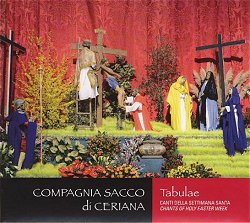Tabulae : chants of Holy Week
Felmay fy 8237
1. Miserere della Misericordia; 2. Stabat Mater di Santa Caterina; 3. Miserere della Visitazione; 4. Domine Jesu Christe; 5. Miserere di Santa Caterina d'Alessandria; 6. Stabat Mater della Visitazione; 7. Miserere di Santa Marta; 8. Lauda da Madona da Vila; 9. Alma Contempla; 10. Quasi Cedrus.
 "This is an absolutely boring reocrd - you'll love it!" said Beppe Greppi, boss of Felmay, as he handed it to me last month. He went on to tell me what a wonderful group of people the Compagnia Sacco are, and that he recorded this CD to mark the 90th aniversary of their founding.
"This is an absolutely boring reocrd - you'll love it!" said Beppe Greppi, boss of Felmay, as he handed it to me last month. He went on to tell me what a wonderful group of people the Compagnia Sacco are, and that he recorded this CD to mark the 90th aniversary of their founding.
Compagnia Sacco is a living proof of polyphonic traditional singing in Ceriana, a small village at the extreme west of the Italian regione of Liguria. The group was formed in 1926, following an initiative of friends and singers, fond of the village’s traditions. In this ancient tradition there is a strong presence of the bordone, a voice which creates a continuous bass structure. The chant is introduced by the baritone (second voice) then the tenor (first voice) comes in with a higher and more acute tone. The bass accompanies and hold the soloists. The polyphony that emerges, sustained by the beauty of the songs, produces deep emotions and a natural vocal harmony. The secular songs of the village are nearly all in Ceriana’s semi-occitan dialect, the sacred ones are in Latin. Compagnia Sacco presents, on this album, the whole collection of the songs performed by the three religious Brotherhoods of Ceriana during the Easter Holy Week.
It was the successors of the original 1926 group - still a relatively informal gathering - that Lomax recorded in 1954 (see my review of Rounder CD 1817), but today's more formal group emerged from performances in Milano in 1966/67, and have taken their music to many other parts of the world in subsequent years.
All I know about the polyphonic traditional singing of Liguria (apart from the truly wonderful trallalero of Genova) can be found in the pages of this CD's booklet, but the socio-cultural background of the Brotherhoods and the actual sound of the singing heard here, makes me think that it is a very close cousin to the Sardinian coro or cuncordo polyphony, that can be heard on the Snatched from Oblivion CD, Sard Polyphonies (SFO 003) - available from the MT Records website. Certainly, the Sardinian singers seem to go for some really unusual harmonies at times, while their Ligurian counterparts usually stick to more 'natural' harmonic forms, making this present disc far easier listening.
All the chants are fairly long and slow, so it will be only possible to let you hear excerpts from them, but here are a couple that have caught my attention. Miserere di Santa Caterina d'Alessandria seems to be a fairly typical example, while Lauda da Madona da Vila exhibits the more or less continual drone of the bordone. It's not boring, and I do love it!
Rod Stradling - 5.7.16
| Top | Home Page | MT Records | Articles | Reviews | News | Editorial | Map |